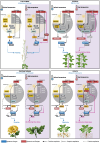Translational insights into abiotic interactions: From Arabidopsis to crop plants
- PMID: 40579370
- PMCID: PMC12292048
- DOI: 10.1093/plcell/koaf140
Translational insights into abiotic interactions: From Arabidopsis to crop plants
Abstract
Understanding crop plants responses to abiotic stress is increasingly important in this changing climate. We asked experts how discoveries in Arabidopsis thaliana have translated into advancements in abiotic crop stress resilience. The theme is that core regulatory networks identified in Arabidopsis are conserved in crops, but the molecular regulation varies among species. For cold tolerance, the regulatory framework is conserved, but MAP Kinase signaling promotes degradation of the INDUCER OF DREB1 EXPRESSION transcription factor in Arabidopsis but inhibits it in rice. For hypoxia, manipulation of the oxygen sensing Arg/N-degron pathway discovered in Arabidopsis has improved waterlogging and flood tolerance in barley, maize, wheat, and soybean. For light signaling, overexpression of PHYTOCHROME B reduces shade avoidance, improving yield under dense planting in potato, soybean, and maize. In rice, understanding of nitrogen responsiveness, uptake, and transport in Arabidopsis has inspired engineering of the NRT1 nitrate transceptor to increase yield. Arabidopsis research has provided leads for genetic manipulations that may improve drought resilience in crop species. Growing plants in space generates a complex array of stresses, and Arabidopsis experiments in the space station prepare for future development of robust crops as integral components of the life support systems. For environmental regulation of flowering time, the role of the GIGANTEA - CONTANS - FLOWERING LOCUS T module elucidated in Arabidopsis is largely conserved in crop plants, although additional regulators modify short-day responsiveness in rice, soybean, chrysanthemum, and potato.
© The Author(s) 2025. Published by Oxford University Press on behalf of American Society of Plant Biologists.
Conflict of interest statement
Conflict of interest statement. None declared.
Figures







References
-
- Abelenda JA, Trabanco N, Olmo ID, Pozas J, Martín-Trillo M, Gómez-Garrido J, Estve-Codina A, Pernas M, Jarillo JA, Pinero M. High ambient temperature impacts on flowering time in Brassica napus through both H2A.Z-dependent and independent mechanisms. Plant Cell Environ. 2023:46(5):1427–1441. 10.1111/pce.14526 - DOI - PubMed
Publication types
MeSH terms
Grants and funding
- ANR-23-CE45-0018/FatRoot and ModLSys projects
- R01 GM134037/GM/NIGMS NIH HHS/United States
- 862858/European Union's Horizon 2020 Research and Innovation program
- Netherlands Organization for Scientific Research
- R35 GM153492/GM/NIGMS NIH HHS/United States
- 20020170100505BA/University of Buenos Aires
- 80NSSC24K0705/NASA Space Biology
- ANR-21-CE13-0019/FatRoot and ModLSys projects
- Prat laboratory lab
- Deliflor Chrysant BV
- PICT-2021-I-A-01070/Agencia Nacional de Promoción Científica y Tecnológica
- 80NSSC23K0380/NASA Space Biology
- PC2023A02004/Pinduoduo-China Agricultural University Research Fund
- 80NSSC19K0126/NASA Space Biology
- NSF MCB-2203275/NIH NIGMS
- PICT-2019-04450/Agencia Nacional de Promoción Científica y Tecnológica
- NSF EF-2222434/NIH NIGMS
- 32230005/National Natural Science Foundation of China
- Yanovsky and Casal laboratories
- NSF DBI-2320251/NIH NIGMS
- MCB-1818111/NSF
- R35GM153492-01/National Institute of General Medical Sciences of the National Institutes of Health
- Agence Nationale de la Recherche
- Utrecht University
- 80NSSC21K0577/NASA Space Biology
LinkOut - more resources
Full Text Sources
Research Materials

